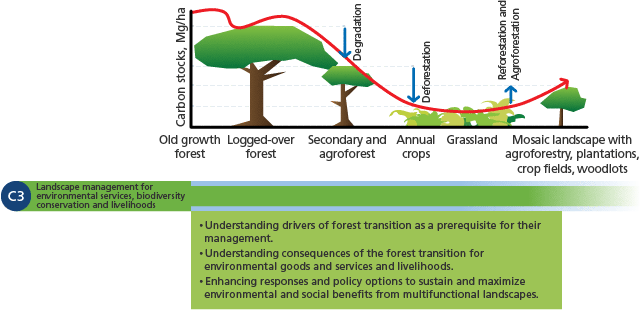FTA Flagship 3 analyzes the localized driving forces behind decline and recovery in ecologically functional forests and tree covers – and the consequences for livelihoods and landscapes. The goal is to provide solutions for the best management of multifunctional landscapes, balancing ecosystem services with market functions and social inclusiveness.
Historically, forested countries have experienced phases of growing and declining forest area. The progress of a country or region along the so-called forest transition curve (see infographic above) has tended to mirror demographic change and economic development.
A central challenge facing integrated landscape management is the institutional dichotomy between “forest” and “non-forest” land. For example, while conservation efforts continue to focus on the management of protected areas, most of the world’s biodiversity occurs outside those areas, primarily in fragmented landscape mosaics with a variety of different land uses.
While the segregation of functions (e.g. strict protected areas adjacent to intensive agriculture) as an approach to natural resource management is possible, the reality is that the boundaries between land uses are often not clearly delineated.
The future flows of environmental goods and services from forested landscapes ultimately depend upon integrated approaches to management, use and conservation. In developing countries, the non-market functions of landscapes such as environmental service provision (e.g. water quality, pest control, carbon sequestration) are often not valued.
Managing landscapes for sustainability and for conservation purposes needs to successfully juggle the trade-offs between the two. This requires more effective land use allocation practices and a better assessment – and management – of environmental services. Our research addresses the key problems of how to manage resources for multiple benefits and multiple stakeholders at landscape level, especially the aspect of preserving natural forests without compromising rural livelihoods.
Conversion of forests has often happened without due consideration of the interests of forest communities and farmers. Weak and unclear tenure and access right regimes have proven particularly problematic. The perspectives of local women have been disregarded. Sustainable forest use and extensive agroforestry have traditionally been excluded from formal land-use planning, despite their importance to forest communities and farmers.
Research into tenure and land rights under Flagship 3 examines negotiation mechanisms and land tenure reforms that can contribute to improved landscape management in fully or partially forested landscapes. It also aims to provide insights into what types of land-use rights lead to better outcomes for conservation and development at the same time.
This Flagship project comprises the following three main research themes:
- understanding the drivers of forest transition (e.g. demographic processes, infrastructure development, tenure reform, policy regulation and incentives, governance and power relations) in order to better manage them and mitigate negative consequences (linked to Flagship 5 on global trade and investment)
- understanding the consequences of forest transition for the provision of environmental goods and services to benefit the poor and disadvantaged (linked with Flagship 1 on smallholder livelihood aspects, Flagship 2 on sustainable forest management and Flagship 4 on climate change)
- Enhancing responses and policy options to sustain and maximize environmental and social benefits from multifunctional landscapes.

